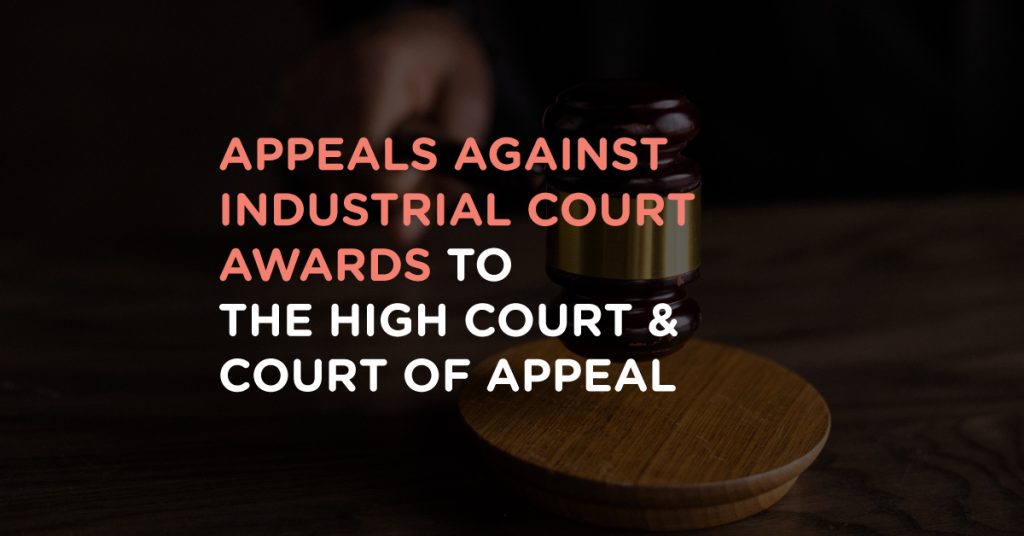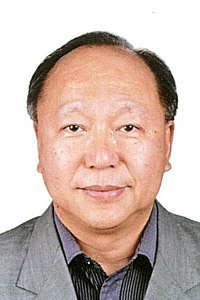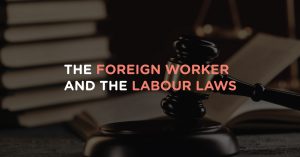

A Write-Up and Commentary (1) Automatic reference of unresolved dismissal cases to the Industrial Court (2) Section 33C IRA 1967: Appeals against Industrial Court Awards to the High Court & Court of Appeal
With effect from 1st Jan 2021, amendments have been made in respect of several provisions of the IRA 1967. In summary, the above amendments were as follows:
In this write-up, I will be sharing my views and comments for practitioners to take note with regard to practical implementation of related areas of the law on “automatic reference of unresolved dismissal cases” and Sec. 33C IRA 1967 on appeals against Industrial Court awards, including via judicial review.
Is it mandatory for claimant to plead for reinstatement at the Industrial Court?
Under Sec. 20 (1) IRA 1967, when a workman considers that he has been dismissed without just cause or excuse by his employer, he may make representations in writing to the DG of IR located nearest to his place of employment to be reinstated in his former employment. The DG of IR shall not entertain any such representations unless they are filed within sixty days of the dismissal.
Previously, in Holiday Inn, Kuching v Elizabeth Lee Chai Siok [1992]1 MLJ 320, the employee filed representation for reinstatement under Sec. 20 IRA 1967. During the hearing before the Industrial Court, the claimant changed her stand and sought for damages (compensation) in-lieu-of reinstatement. The High Court then ruled that the claimant could not come within the provisions of Sec. 20 (1) and (3) of the IRA 1967. The legislature had intended that recourse to the Industrial Court is only in respect of reinstatement and that the Industrial Court is no longer seized with jurisdiction once reinstatement is no longer being applied for. It went on to say that as reinstatement has been abandoned during the court hearing, there was no longer a basis to award compensation in lieu of reinstatement.
In the case of The Borneo Post Sdn Bhd v Margaret Wong [2001] 8 CLJ 758, the High Court took an opposite position. Even though the claimant had failed to plead reinstatement at the Industrial Court, it still had the jurisdiction to hear and determine the case. Upon an application for judicial review, the High Court held that the failure of the claimant to plead reinstatement is not fatal. The High Court, inter alia, held that:
“….. In my view, it is misleading, as the Industrial Court stated in its ruling, to say the respondent does not want reinstatement. I think it would be more accurate to say that she wanted reinstatement but that it would be inexpedient in her circumstances for the Industrial Court to order it which accounts for her omission to ask for it.
As I said earlier, whether or not reinstatement must be expressly prayed for in the statement of case is a point of procedure. The omission in the statement of case to state it as a specific relief does not affect the jurisdiction of the Industrial Court to hear and determine the case on the merits: see s 29 (d) of the Industrial Relations Act. The Industrial Court derives it jurisdiction from the order of reference by the Minister made under s. 20 (3) of the Industrial Relations Act and which such court must exercise, so it was held in Assunta Hospital v Dr. A Dutt [1981] 1 MLJ 115.”
In Hana International Sdn Bhd v Tan Thien Cheng [2002] 1 ILR 551, the Industrial Court applied the relevant authorities including “The Borneo Post” case, and arrived at the following:
“…. Therefore, in the present case, even though reinstatement had not been pleaded by the claimant in his Statement of Case and no evidence was adduced by him in court that he is applying for reinstatement, the court is satisfied that it had jurisdiction to hear the case.
Under Sec. 20 (1) of the IRA 1967, it is clear that the claimant is permitted to make representations in writing to the Director General of Industrial Relations to be reinstated in his former employment. It is therefore incumbent upon the Director General at that stage to ensure that the claimant had stated in his written representations that he is asking for reinstatement. Otherwise, the Director General would not be legally bound to entertain such representations and take effective steps to settle the representations. If settlement cannot be arrived, then the Director General notifies the Minister accordingly under s 20 (2) of the IRA 1967. If the Minister thinks fit, he may, under s. 20 (3) of the IRA 1967, refer the representations to the court for an award.
Finally, when the representations are made to the court, the court will, due to the legal procedure provided by s. 20 of the IRA 1967, exercise jurisdiction over the matter on the assumption and basis that, in the first place, the claimant would have made representations in writing under s. 20 (1) of the IRA 1967 for reinstatement in his former employment…..Clearly, it is implicit that any reference made by the Minister under s. 20 (3) of the IRA 1967 is in respect of representations for reinstatement, which had been duly and properly made by the claimant under s. 20 (1) of the same Act. In view of the above consideration, at this stage, the court is satisfied that it has jurisdiction to hear the claimant’s case even though he had not pleaded reinstatement in his Statement of Case.”
In the recent case of Sanbos (Malaysia) Sdn Bhd v Gan Soon Huat [2021] MLJU 498, the COA held that it was no longer a mandatory requirement for a claimant to plead reinstatement as a remedy and that a failure to plead reinstatement as such was not fatal to an unfair dismissal claim. The Industrial Court had dismissed the claim for constructive dismissal on grounds that:
During judicial review, the High Court held that the Industrial Court had erred in law, which was echoed by the COA which was of the view that there was no requirement to plead reinstatement as a remedy/relief as that is only material at the time of representations made to the DG of IR pursuant to Sec. 20 (1) IRA 1967.
Comments
Employers should be cognizant that a failure to seek reinstatement at the Industrial Relations department would be fatal to a claimant’s case as it contravenes the statutory requirements of Sec. 20 (1) IRA 1967. On the other hand, where a reinstatement is offered to a claimant at the IR Department and the claimant refuses to accept such reinstatement, the claimant’s case under Sec. 20 (1) IRA would come to an end. The matter is considered resolved and shall no longer be referred to the Industrial Court for adjudication.
Employers should take note that where reinstatement is offered, a claimant can always return to work, and submits his resignation anytime soon thereafter, and still be eligible to receive his salary from the date of dismissal to the date of his reinstatement. In cases where the claimant has secured another employment, especially a higher paying job, he will still need to serve his notice (be it 2 months or 3 months) or pay indemnity in-lieu of notice to his employer. He will only be saved from having to make such indemnity payments or serve such notice period if his new employer is willing to pay his previous employer the indemnity payment in lieu of his notice period.
Automatic Reference of unresolved Dismissal Cases to the Industrial Court
Since 1st January 2021, dismissal cases that are unsuccessfully conciliated at the IR Department shall automatically be referred by the DG of IR to the Industrial Court for adjudication.
In respect of dismissal cases that are unsuccessfully conciliated at the IR Department, Sec. 20 (3) of the IRA provides that:
“Where the Director General is satisfied that there is no likelihood of the representations being settled under subsection (2), the director General shall refer the representations to the Court for an award”.
Comments
Employers should take note that in respect of dismissal cases, the power to refer such dismissal cases to the Industrial Court no longer lie with the Minister of HR as was the case prior to 1st Jan 2021. The power for such reference is now vested in the DG of IR by virtue of Sec. 20 (3) of the IRA, as shown above. However, there is no prescribed time limit stated in the IRA 1967 for the DG of IR to determine if he “is satisfied that there is no likelihood of settlement”. It will be up to the DG of IR to take reasonable measures and time frame, fairly and impartially to successfully conciliate such dismissal cases to prevent an inundation of dismissal cases to the Industrial Court due to the “automatic reference” of all unresolved dismissal cases effective 1st Jan 2021.
Sec. 33C of the IRA 1967 – Is Judicial Review still applicable to appeal against an Industrial Court Award to the High Court?
It is noteworthy that the new provision in Sec. 33C above provides a direct appeal against an Award of the industrial Court to the High Court. Section 33C of the IRA provides that:
With the above, challenges to Industrial Court Awards handed down after 1st January 2021 is by way of appeal to the High Court as per Sec. 33C IRA. While an appeal is in process, employers must take note that reinstatement of a workman shall not be subject to any stay of proceedings in any court: Sec. 33B (2) IRA 1967.
Where an appeal provision is available, it was held in the Supreme Court case of Government of Malaysia v Jagdis Singh [1987] 2 MLJ 185 that certiorari should not be issued unless there is a clear lack of jurisdiction or blatant failure to perform some statutory duty or serious breach of principles of natural justice. In short, judicial review to set aside Industrial Court awards are still available but under very limited circumstances.
Where lies the difference between Judicial Review and an appeal under Sec. 33C IRA?
(a) Principles of Intervention
In a judicial review, the High Court plays a supervisory role to review the substance of the Industrial Court’s decision. Thus, it has limited jurisdiction as it cannot review the evidence and substitute the findings of the industrial Court with its own. Where the High Court is exercising its appellate jurisdiction, it may reassess and analyse the evidence and is therefore, more inclined to interfere with the Industrial Court’s findings of fact based on other available or proved facts, or where the credibility or reliability of any witness are impugned.
A judicial review application may result in the quashing of the Industrial Court award only where the Industrial Court has committed an error of law on any of the grounds resulting in illegality, irrationality, proportionality and procedural impropriety. In an appeal, there are wider scope and grounds to challenge an Industrial Court award and not limited to errors of law only, as in the case of judicial review. In an appeal, the High Court may overturn an award of the Industrial Court due to errors of law and facts arising from lack of judicial appreciation of relevant evidence by the Industrial Court.
(b) Admissibility of Fresh Evidence in an Appeal
While it is not allowed in judicial reviews, in an appeal before the High Court, fresh evidence may be admitted if the High Court Judge is satisfied that:
(c) Leave of the Court is not Required
Prior to 1st Jan 2021, the dissatisfied party is required to obtain leave of the Court before making the application for judicial review. Presently, Order 55 r.3 Rules of Court 2016 provides that the notice of appeal shall be filed at the Court where the decision is being appealed. Herein, the dissatisfied party would only be required to file a notice of appeal within 14 days from the date of receipt of the Industrial Court award. The other party may file a notice of cross appeal within 14 days from the receipt of date of service of the record of appeal.
In the case of an appeal from the High Court to the Court of Appeal, where the value of the claim is less than RM250,000.00, the applicant shall have the burden to demonstrate that there was:
(d) For Industrial Court Matters, the Highest Appellate Court is the Court of Appeal
Prior to 1st January 2021, a challenge against the High Court in a judicial review application may, with the leave of the court, be escalated till the Federal Court. Currently, as Sec. 33C provides that the award of the Industrial Court shall be regarded as a decision from the Sessions Court for purpose of an appeal, the Court of Appeal is now the highest court for any challenge against an Industrial Court award.
In Noraini bte Omar v Rohani bin Said [2006] 3 MLJ 150, the COA held that it is at liberty to depart from the decision of the Federal Court if the decision is wrong, because it stands at the apex with regards to claims that are solely within the jurisdiction of the subordinate courts. As such, it will not be surprising to see the COA being the final appellate court on matters originating from the Industrial Court to refuse to be bound by a preceding decision of the Federal Court in some future cases.
(e) Shorter Time for filing an Appeal
Previously, the dissatisfied party was given up to 3 months from the date of receipt, to challenge the Industrial Court award by way of judicial review. Under Sec. 33C of the IRA, an appeal must now be made within 14 days of receipt of the Industrial Court award, giving the dissatisfied party a shorter time to make up his mind.
Comments
Employers should consult their legal department and external specialist lawyers whether to file an appeal under Sec. 33C of the IRA 1967 against an Industrial Court award handed down in favour of a claimant, if they have strong grounds to do so. They must also be aware that any challenge by way of judicial review against an Industrial Court award can now be made only under very limited circumstances, as explained above. Of importance to note is that the number of appeals from the Industrial Court has now been reduced from three to two, with the COA being the highest appellate Court.
While the Industrial Court decides cases based on equity and good conscience, it remains to be seen whether the appellate Courts would be inclined to apply judicial principles in a similar vein (based on equity and good conscience) or differently, when exercising its appellate jurisdiction and role.

DBA (UniSA), MBA (Hull), CLP (LPQB), LL. B (London)


